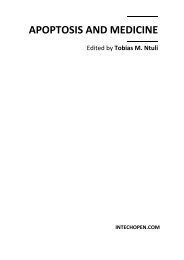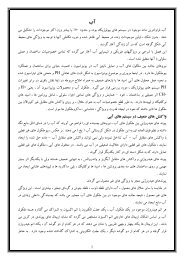RNA interference: traveling in the cell and gaining functions?
RNA interference: traveling in the cell and gaining functions?
RNA interference: traveling in the cell and gaining functions?
You also want an ePaper? Increase the reach of your titles
YUMPU automatically turns print PDFs into web optimized ePapers that Google loves.
Review TRENDS <strong>in</strong> Genetics Vol.19 No.1 January 2003 45Argonaute-like prote<strong>in</strong>s ALG-1 <strong>and</strong> ALG-2 have also beenattributed to <strong>the</strong> improper process<strong>in</strong>g of mi<strong>RNA</strong> precursors<strong>and</strong> a reduction <strong>in</strong> mature st<strong>RNA</strong> expression [3,74].Itis <strong>the</strong>refore tempt<strong>in</strong>g to propose <strong>the</strong> existence of ancient,mi<strong>RNA</strong>-mediated mechanisms that regulate endogenousgenes <strong>in</strong> eukaryotes. But most endogenous small <strong>RNA</strong>scloned from animals, <strong>and</strong> several from plants, do notmatch prote<strong>in</strong>-cod<strong>in</strong>g or structural <strong>RNA</strong>s <strong>and</strong> <strong>the</strong>irmechanistic roles, with <strong>the</strong> exception of C. elegans st<strong>RNA</strong>s,rema<strong>in</strong> unknown [55,70,74].Dicer processes precursor ds<strong>RNA</strong>s to make both si<strong>RNA</strong>s<strong>and</strong> mi<strong>RNA</strong>s. In organisms encod<strong>in</strong>g only one Dicer, as<strong>in</strong>gle pathway might h<strong>and</strong>le small <strong>RNA</strong>s. In o<strong>the</strong>r words,<strong>the</strong> mi<strong>RNA</strong> <strong>and</strong> si<strong>RNA</strong> pathways might be <strong>in</strong>terchangeablefrom biogenesis of <strong>the</strong> small <strong>RNA</strong> to <strong>in</strong>teraction withits target. The f<strong>in</strong>al outcome, such as m<strong>RNA</strong> degradationor, for example, translational repression, would depend on<strong>the</strong> degree of complementarity to <strong>the</strong> target <strong>RNA</strong> <strong>and</strong>,presumably, on associated effector prote<strong>in</strong>s [3,17]. Thismodel is consistent with <strong>the</strong> f<strong>in</strong>d<strong>in</strong>gs that short hairp<strong>in</strong><strong>RNA</strong>s, resembl<strong>in</strong>g mi<strong>RNA</strong> precursors, can <strong>in</strong>duce <strong>RNA</strong>i onperfectly homologous target m<strong>RNA</strong>s [3,17], <strong>and</strong> that <strong>the</strong>human RISC seems to be equivalent to <strong>the</strong> 15S miRNPthat is associated with many mi<strong>RNA</strong>s [17,55]. Alternatively,two dist<strong>in</strong>ct pathways, <strong>in</strong>tersect<strong>in</strong>g at <strong>the</strong> Dicercatalyzed step, might be <strong>in</strong>volved <strong>in</strong> <strong>the</strong> generation <strong>and</strong>function of at least some mi<strong>RNA</strong>s <strong>and</strong> si<strong>RNA</strong>s [3]. This issupported by <strong>the</strong> requirement of different Argonauteprote<strong>in</strong>s for <strong>the</strong> production of functional st<strong>RNA</strong>s or si<strong>RNA</strong>s<strong>in</strong> C. elegans [16,19,74]. In organisms where Dicer isencoded by a multigene family, such as Arabidopsis [57,58],cytoplasmic <strong>and</strong> nuclear process<strong>in</strong>g pathways mightoperate.Recent f<strong>in</strong>d<strong>in</strong>gs have also implicated small <strong>RNA</strong>s <strong>in</strong>chromat<strong>in</strong> <strong>and</strong>/or DNA modifications <strong>and</strong> genomerearrangements, such as heterochromat<strong>in</strong> formation<strong>in</strong> S. pombe <strong>and</strong> DNA elim<strong>in</strong>ation <strong>in</strong> Tetrahymena[1,35,49,65–68]. This suggests that ds<strong>RNA</strong>-mediatedprocesses might have a role <strong>in</strong> genome organization <strong>and</strong>transcriptional control. It is clear that despite muchprogress result<strong>in</strong>g from a comb<strong>in</strong>ation of genetics <strong>and</strong>biochemistry, we are only just beg<strong>in</strong>n<strong>in</strong>g to underst<strong>and</strong> <strong>the</strong>mechanistic complexity of <strong>RNA</strong>-mediated silenc<strong>in</strong>g, itsbiological implications, <strong>and</strong> <strong>the</strong> differences <strong>and</strong> similaritiesamong different eukaryotes.AcknowledgementsI thank S. Jacobsen, T. Clemente <strong>and</strong> members of mylaboratory for helpful comments. My apologies to colleagueswhose work could not be cited due to spacelimitations. Supported by NIH grant GM62915.References1 Matzke, M. et al. (2001) <strong>RNA</strong>: guid<strong>in</strong>g gene silenc<strong>in</strong>g. Science 293,1080–10832 Vance, V. <strong>and</strong> Vaucheret, H. (2001) <strong>RNA</strong> silenc<strong>in</strong>g <strong>in</strong> plants – defense<strong>and</strong> counterdefense. Science 292, 2277–22803 Hannon, G.J. (2002) <strong>RNA</strong> <strong><strong>in</strong>terference</strong>. Nature 418, 244–2514 Plasterk, R.H.A. (2002) <strong>RNA</strong> silenc<strong>in</strong>g: <strong>the</strong> genome’s immune system.Science 296, 1263–12655 Zamore, P.D. (2002) Ancient pathways programmed by small <strong>RNA</strong>s.Science 296, 1265–12696 Zamore, P.D. et al. (2000) <strong>RNA</strong>i: double-str<strong>and</strong>ed <strong>RNA</strong> directs <strong>the</strong>ATP-dependent cleavage of m<strong>RNA</strong> at 21 to 23 nucleotide <strong>in</strong>tervals. Cell101, 25–337 Bernste<strong>in</strong>, E. et al. (2001) Role for a bidentate ribonuclease <strong>in</strong> <strong>the</strong><strong>in</strong>itiation step of <strong>RNA</strong> <strong><strong>in</strong>terference</strong>. Nature 409, 363–3668 Hammond, S.M. et al. (2000) An <strong>RNA</strong>-directed nuclease mediates posttranscriptionalgene silenc<strong>in</strong>g <strong>in</strong> Drosophila <strong>cell</strong>s. Nature 404,293–2969 Nykänen, A. et al. (2001) ATP requirements <strong>and</strong> small <strong>in</strong>terfer<strong>in</strong>g <strong>RNA</strong>structure <strong>in</strong> <strong>the</strong> <strong>RNA</strong> <strong><strong>in</strong>terference</strong> pathway. Cell 107, 309–32110 Mart<strong>in</strong>ez, J. et al. (2002) S<strong>in</strong>gle-str<strong>and</strong>ed antisense si<strong>RNA</strong>s guidetarget <strong>RNA</strong> cleavage <strong>in</strong> <strong>RNA</strong>i. Cell 110, 563–57411 Elbashir, S.M. et al. (2001) <strong>RNA</strong> <strong><strong>in</strong>terference</strong> is mediated by 21- <strong>and</strong> 22-nucleotide <strong>RNA</strong>s. Genes Dev. 15, 188–20012 Holen, T. et al. (2002) Positional effects of short <strong>in</strong>terfer<strong>in</strong>g <strong>RNA</strong>starget<strong>in</strong>g <strong>the</strong> human coagulation trigger tissue factor. Nucleic AcidsRes. 30, 1757–176613 Han, Y. <strong>and</strong> Grierson, D. (2002) Relationship between small antisense<strong>RNA</strong>s <strong>and</strong> aberrant <strong>RNA</strong>s associated with sense transgene mediatedgene silenc<strong>in</strong>g <strong>in</strong> tomato. Plant J. 29, 509–51914 Hammond, S.M. et al. (2001) Argonaute2, a l<strong>in</strong>k between genetic <strong>and</strong>biochemical analyses of <strong>RNA</strong>i. Science 293, 1146–115015 Bohmert, K. et al. (1998) AGO1 def<strong>in</strong>es a novel locus of Arabidopsiscontroll<strong>in</strong>g leaf development. EMBO J. 17, 170–18016 Tabara, H. et al. (1999) The rde-1 gene, <strong>RNA</strong> <strong><strong>in</strong>terference</strong>, <strong>and</strong>transposon silenc<strong>in</strong>g <strong>in</strong> C. elegans. Cell 99, 123–13217 Hutvágner, G. <strong>and</strong> Zamore, P.D. (2002) A micro<strong>RNA</strong> <strong>in</strong> a multipleturnover<strong>RNA</strong>i enzyme complex. Science 297, 2056–206018 Cerutti, L. et al. (2000) Doma<strong>in</strong>s <strong>in</strong> gene silenc<strong>in</strong>g <strong>and</strong> <strong>cell</strong>differentiation prote<strong>in</strong>s: <strong>the</strong> novel PAZ doma<strong>in</strong> <strong>and</strong> redef<strong>in</strong>ition of<strong>the</strong> Piwi doma<strong>in</strong>. Trends Biochem. Sci. 25, 481–48219 Tabara, H. et al. (2002) The ds<strong>RNA</strong> b<strong>in</strong>d<strong>in</strong>g prote<strong>in</strong> RDE-4 <strong>in</strong>teractswith RDE-1, DCR-1, <strong>and</strong> a DExH-box helicase to direct <strong>RNA</strong>i <strong>in</strong>C. elegans. Cell 109, 861–87120 Grishok, A. et al. (2000) Genetic requirements for <strong>in</strong>heritance of <strong>RNA</strong>i<strong>in</strong> C. elegans. Science 287, 2494–249721 Kett<strong>in</strong>g, R.F. et al. (1999) Mut-7 of C. elegans, required for transposonsilenc<strong>in</strong>g <strong>and</strong> <strong>RNA</strong> <strong><strong>in</strong>terference</strong>, is a homolog of Werner syndromehelicase <strong>and</strong> RNaseD. Cell 99, 133–14122 Kennerdell, J.R. <strong>and</strong> Car<strong>the</strong>w, R.W. (1998) Use of ds<strong>RNA</strong>-mediatedgenetic <strong><strong>in</strong>terference</strong> to demonstrate that frizzled <strong>and</strong> frizzled 2 act <strong>in</strong><strong>the</strong> w<strong>in</strong>gless pathway. Cell 95, 1017–102623 Svoboda, P. et al. (2000) Selective reduction of dormant maternalm<strong>RNA</strong>s <strong>in</strong> mouse oocytes by <strong>RNA</strong> <strong><strong>in</strong>terference</strong>. Development 127,4147–415624 Ratcliff, F. et al. (1997) A similarity between viral defense <strong>and</strong> genesilenc<strong>in</strong>g <strong>in</strong> plants. Science 276, 1558–156025 Bitko, V. <strong>and</strong> Barik, S. (2001) Phenotypic silenc<strong>in</strong>g of cytoplasmicgenes us<strong>in</strong>g sequence-specific double-str<strong>and</strong>ed short <strong>in</strong>terfer<strong>in</strong>g <strong>RNA</strong><strong>and</strong> its application <strong>in</strong> <strong>the</strong> reverse genetics of wild type negative-str<strong>and</strong><strong>RNA</strong> viruses. BMC Microbiol. 1, 34–4526 Williams, R.W. <strong>and</strong> Rub<strong>in</strong>, G.M. (2002) ARGONAUTE1 is required forefficient <strong>RNA</strong> <strong><strong>in</strong>terference</strong> <strong>in</strong> Drosophila embryos. Proc. Natl Acad.Sci. USA 99, 6889–689427 Kataoka, Y. et al. (2001) Developmental roles <strong>and</strong> molecularcharacterization of a Drosophila homologue of Arabidopsis Argonaute1,<strong>the</strong> founder of a novel gene superfamily. Genes Cells 6,313–32528 Harris, A.N. <strong>and</strong> Macdonald, P.M. (2001) auberg<strong>in</strong>e encodes aDrosophila polar granule component required for pole <strong>cell</strong> formation<strong>and</strong> related to eIF2C. Development 128, 2823–283229 Zeng, Y. <strong>and</strong> Cullen, B.R. (2002) <strong>RNA</strong> <strong><strong>in</strong>terference</strong> <strong>in</strong> human <strong>cell</strong>s isrestricted to <strong>the</strong> cytoplasm. <strong>RNA</strong> 8, 855–86030 Billy, E. et al. (2001) Specific <strong><strong>in</strong>terference</strong> with gene expression <strong>in</strong>ducedby long, double-str<strong>and</strong>ed <strong>RNA</strong> <strong>in</strong> mouse embryonal teratocarc<strong>in</strong>oma<strong>cell</strong> l<strong>in</strong>es. Proc. Natl Acad. Sci. USA 98, 14428–1443331 Cikaluk, D.E. et al. (1999) GERp95, a membrane-associated prote<strong>in</strong>that belongs to a family of prote<strong>in</strong>s <strong>in</strong>volved <strong>in</strong> stem <strong>cell</strong> differentiation.Mol. Biol. Cell 10, 3357–337232 Wesley, S.V. et al. (2001) Construct design for efficient, effective <strong>and</strong>high-throughput gene silenc<strong>in</strong>g <strong>in</strong> plants. Plant J. 27, 581–59033 Kalidas, S. <strong>and</strong> Smith, D.P. (2002) Novel genomic cDNA hybridshttp://tigs.trends.com






